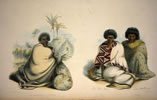Tribal organisation
Traditionally Māori society was based around whānau, hapū and iwi. European settlement from the 19th century saw changes in social and political structures which led to the formation of new kinds of Māori organisations. Though new organisations appeared, in the 19th century Māori groups continued to be largely kin-based and centred around rural marae.
Pan-tribal organisations
Concern about land alienation and, later, warfare against the government led to the formation of pan-tribal organisations. In the 19th century these took the form of both political and religious movements.
Te Wakaminenga – United Tribes of New Zealand
Perhaps the earliest example of a pan-tribal Māori organisation was the United Tribes of New Zealand (Te Wakaminenga o Nu Tirene). This group was referred to in the New Zealand Declaration of Independence, Te Wakaputanga o te Rangatira o Nu Tirene.
On 28 October 1835 the British resident, James Busby, organised for a group of rangatira to sign the declaration. The group discussed meeting as a congress once a year, though this never happened. The confederation was referred to in the Treaty of Waitangi as one of the groups signing up to the treaty. In the treaty it was named Te Wakaminenga o nga Hapu o Nu Tirani (Confederation of the United Tribes of New Zealand).
Kīngitanga
The Kīngitanga, the King Movement, began in the 1850s as a response to the pressure on Māori to sell land. A number of different iwi agreed on Te Wherowhero, a Waikato chief, as the first Māori king. He became known as Pōtatau Te Wherowhero.
The New Zealand wars of the 1860s saw the Waikato tribes stripped of most of their lands, which had a devastating effect on the Kīngitanga. However, the movement continues in the 2000s.
Government-sponsored rūnanga
In the 1860s Governor George Grey attempted to establish a rūnanga system composed of eight civil commissioners and 22 resident magistrates. The first rūnanga was set up at Waimate North in 1862. The rūnanga system was more successful in the Far North than in other areas.
Religious movements
The introduction of Christianity to New Zealand in the early 19th century led to growing numbers of Māori joining churches. Soon Māori prophets created their own movements based around the Old and New Testaments of the Bible.
Te Ua Haumēne was a prophet who formed the religious movement Pai Mārire, which also had a political aspect. Followers of the movement, known widely as Hauhau, spread through the North Island as missionaries, and Pai Mārire became a pan-tribal movement.
The prophets Te Whiti-o-Rongomai and Tohu Kākahi at Parihaka also attracted pan-tribal support for their religious community.
Repudiation movement
The Repudiation movement developed among Ngāti Kahungunu of Hawke’s Bay from 1871 in an attempt to reverse unfair sales of land. It was headed by Hēnare Matua, and had its own newspaper, Te Wananga. The movement was supported by two Pākehā politicians, Henry Russell and John Sheehan.
Kotahitanga
Kotahitanga (unity) movements began to form from the 1880s. Their main purpose was to bring together tribal groups to lobby for fairer land laws. There were two kotahitanga movements in the north, among the Ngāpuhi and Ngāti Whātua tribes.
Kotahitanga came together as the Kotahitanga Parliament in the 1890s. This was a national movement with support from a number of different tribes.



